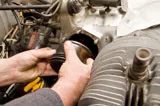|
Federal Aviation RegulationsFederal Aviation Regulations (FAR’s) are mandates for controlling all aspects of aviation in the United States. The regulations are established and enforced by the Federal Aviation Administration (FAA), and are part of Title 14 of the Code of Federal Regulations (CFR). The primary objectives of FAR’s are ensuring safe aviation procedures and programs. Besides protecting aviation employees and the general public, FARs also protect the national security of the United States. Due to the wide variety of aviation activities, FAR’s are organized into parts under the CFR by their specific aviation activity, with some parts containing thousands of sections. For example, regulated aviation activities include: temporary flight restrictions (due to national events or presidential matters), aircraft design, pilot training, parachute operations, flight schools, maintenance training schools, repair stations, and even hot-air ballooning to name a few. It is important to note that FAR’s are designed to control the certifications for airports, aviation schools, repair stations, pilots, and other aviation workers. Once a certification has been issued, such as a repair station certificate, the FAA conducts regular audits to ensure continued compliance is maintained. FAR’s are periodically revised in order to maintain the highest safety standards. Federal Aviation Regulations For AirworthinessThe FAA issues production approvals to companies who produce aircraft, engines, or parts thereof. These approvals are outlined in FAR Part 21. When aircraft or engines are manufactured, they must be manufactured to a specific set of standards. Those standards are published by the FAA in the form a FAR’s. In the process of producing aviation articles the manufacturer must comply with one of the following regulations, as applicable: FAR Part 23 - details the airworthiness standards for airplanes with a maximum take-off weight of less than 12,500 lbs., such as the Cessna 172 and Cirrus SR20. FAR Part 25 - details the airworthiness standards for airplanes with a maximum take-off weight of 12,500 lbs. or more, such as the Boeing 737 or Airbus A320. FAR Part 26 - Details continued airworthiness standards and safety improvements for large transport category airplanes, such as the Boeing 737 and Airbus A320. FAR Part 27 - details the airworthiness standards for helicopters with a maximum take-off weight of less than 12,500 lbs., such as the Bell 407 or Eurocopter EC120B. FAR Part 29 - details the airworthiness standards for helicopters with a maximum take-off weight of 12,500 lbs. or more, such as the Bell 412 or Boeing Chinook. FAR Part 33 - details the airworthiness standards for both reciprocating and turbine aircraft engines such as the Lycoming IO-540 or the Pratt & Whitney PW4000. FAR Part 35 - details the airworthiness standards for aircraft propellers such as those made by McCaulley or Hartzel. Once an aviation article is produced, the maintenance and inspections (continued airworthiness) of those articles is regulated by the following FAR's: FAR Part 43 – is the rule that governs the continued maintenance, preventive maintenance, rebuilding and alteration of the above-mentioned articles after they have been manufactured. FAR Part 145 – is the rule that governs aircraft repair station activities, and the personnel working in repair stations. Each regulation may have multiple levels of standards. For example, aircraft performance standards include specifications for stall speed, rate of climb, take-off speed, and the average weight of pilot, passengers, and crew. Federal Aviation Regulations For Aviation EmployeesPilots, aircraft maintenance technicians, and other aviation workers will need specific certifications relating to their field and job description. For pilots, Federal Aviation Regulations are classified according to the type of flying being performed and the type of aircraft flown. Pilots seeking to fly commercially will need to adhere to higher safety standards and training. FAR Part 141 - contains the regulations regarding the standards for private and commercial pilot training. FAR Part 61 - governs the certification and operating rules for all pilots. General aviation pilots, such as private pilots, flight instructors, and ground instructors, face less intense training then that of commercial pilots. Aviation maintenance technicians seeking to work in the aviation industry will also need to adhere to high safety standards. FAR Part 147 - contains the regulations regarding the standards for aviation maintenance technician training. FAR Part 65 - governs the certification and operating rules for all aviation maintenance technicians. Read more about this topic on the following pages: How Air Travel Regulations Maintain Safety FAR Part 145 Repair Station Certification EASA Part 145 Repair Station Certification |
|
|
||







